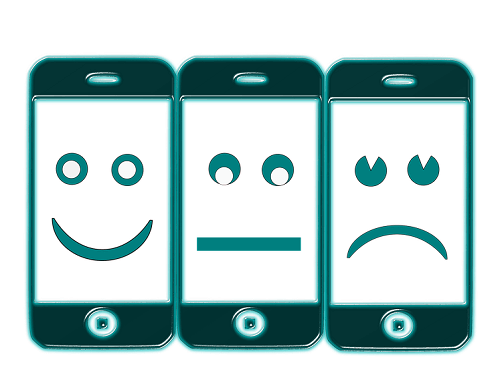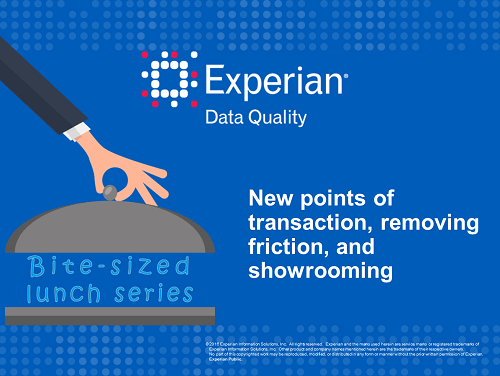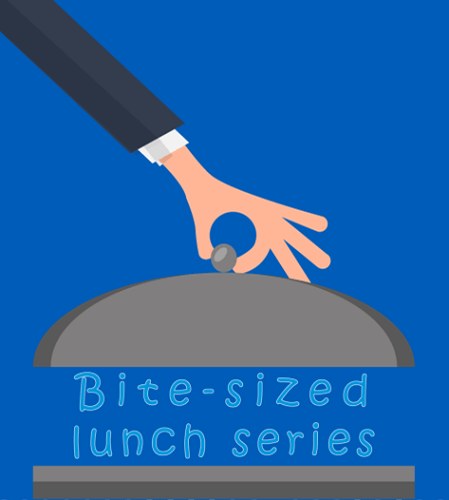- Products

Enjoy a free 30-day trial of our
data validation software.Experience the power of trusted data
solutions today, no credit card required! - Solutions

Enjoy a free 30-day trial of our
data validation software.Experience the power of trusted data
solutions today, no credit card required! - Partners

Enjoy a free 30-day trial of our
data validation software.Experience the power of trusted data
solutions today, no credit card required! - Learn more
- Pricing
- Contact Us
Mobile customer engagement best practices

Whether we are talking about store associates wielding mobile POS devices or consumers sporting their mobile phones, mobile digital transactions are on the rise and gaining in importance. The latest studies* show that online purchasing has now become the preference, just beating out other forms of purchasing (e.g. store, catalog) by 51 percent to 49 percent. And 77 percent of mobile phone users have used their devices during the shopping process, with over 40 percent having completed a mobile purchase. This number rises to over 60 percent for Millennials. Clearly online and in particular, mobile online shopping, is redefining the shopping experience for a large portion of the population.
*Reference: UPS Pulse of the Online Shopper™ U.S. Study, June 2016
What’s more, customer satisfaction with online experiences is far higher than satisfaction with shopping in stores—almost 25 percent higher. Even satisfaction with mobile shopping, despite the smaller screen size and keyboard limitations, is higher than compared to store shopping. Yet the majority of shoppers still value their store visits, at least for part of their buying journey, particularly where facets such as style, size, fit, match, color, or immediate availability are important.
This begs the question, “How can stores improve the customer experience by melding the best attributes of online and mobile shopping with the benefits of store attributes?”
Online shopping, whether via desktop PC or mobile, offers a range of perceived benefits, including:
- Lower pricing (particularly from marketplaces and via online search)
- Pricing comparisons
- Greater selection of products and options
- Product reviews
- Social sharing
- Free or discounted shipping
- Delivery tracking and notification
Store shopping offers alternative perceived benefits, including:
- Excitement of seeking deals
- Gaining knowledge/advice from sales associate
- Test/try/feel/see actual product
- Gathering of ideas and possibilities
- Instant availability of in-stock items
Supporting store shoppers via online devices, whether their own or available in the store, has the potential of not only increasing the value of the store visit but also significantly improving their brand satisfaction. Yet care is needed. Poor implementation and non-optimized workflows can have the opposite effect. Not recognizing and engaging customers before they reach the checkout will reduce potential order value. Deploying store associates who are ignorant of online technologies will decrease satisfaction. Supporting technology but not being able to identify inventory will increase frustration.
Here are seven recommended best practices for supporting and engaging shoppers by leveraging online and mobile devices while they are in the store.
- At the very minimum, make sure your website has a responsive design. Today’s shoppers expect a seamless experience regardless of how they’re shopping. Seeing one thing on a PC screen, something different on their mobile, and something different again when they look over the associates shoulder at his/her tablet is unacceptable.
- Seamlessness across channels should mean that retailers are neutral when it comes to how the purchase is ultimately made. Staff can be more optimally deployed if customers have the choice of completing their purchases via a fixed or mobile POS, a kiosk, or their mobile phones.
- Average order value can be increased by encouraging customers to identify themselves when they first enter the store. As Boston Retail Partners state in their latest research report on customer experience and unified commerce, “Customer identification and personalization not only improves the overall customer experience, but also provides additional engagement opportunities such as clienteling and guided selling.” The key to self-identification is a value proposition that makes it worth the customer’s effort. For example, to obtain:
- Personalized offers
- Ability to check/order stock in any of the retailers locations
- Event and/or product information/incentives
- Online receipts and credits
- Interactions from in-store technologies (such as beacons)
- Self-identification can be done via a dedicated app or via the use of an advertised offer: “Text this number to obtain your personalized discount” or “Click this QBR code.” Apps tend to appeal to existing customers but their take-up is limited. Approaches that use mobile phone features (such as text messaging or camera) tend to be less intrusive. Either can work. In the latter case, and when collecting identifier or contact information, it’s important to minimize the number of keystrokes required. The longer it takes to enter information, the greater the likelihood of frustration and abandonment.
- The ID or contact information should be immediately validated to make sure it is correct and ensure that the correct customer is identified. A valid customer ID, such as a phone number or email address, enables personalized messages to be sent to the customer immediately. It also supports the real-time look up of customer data that can be used to inform the message and offers. “Welcome back. Your last visit was on…,” “Today we have ABC on sale, your personal discount is X%.”
- Personalization is king when it comes to maximizing consumer spending. Consider augmenting purchase information with lifestyle, demographic, and psychographic information. Knowing that it’s someone’s birthday, that they recently made a large purchase (house/boat/car), or that they have certain preferences (always buys top brand products) can significantly improve the impact of offers and incentives.
- Apart from inventory management, staff management and training is probably the next major issue for retailers. Retail turnover remains significant so it makes limited sense to train associates on products. Better results can be obtained by training them on technology. Associates should have access to all the information that a mobile consumer would have, plus added information about the consumer. They all need to be mobile themselves within the store so that they can reach out to customers where they are and avoid the creation of lines. In that way, they will be familiar enough to help overcome difficulties, and can identify information the shopper may have missed. They’ll also be able to more proactively greet and treat shoppers with personal care and attention (being able to access their shopping records), make personalized recommendations, quickly and easily update their account information by requesting minimal information, (e.g. zip code, first few characters of the street address, apartment number), and enter online orders on their behalf (for example to obtain a product from another location).
The mobile shopping revolution promises to change retail forever. It will likely significantly improve customer satisfaction for agile retailers and eliminate the laggards.
To read the latest research on customer experience and unified commerce click the button below to download Boston Retail Partners 2016 Customer Experience / Unified Commerce Benchmark Survey results whitepaper, sponsored by Experian Data Quality.




